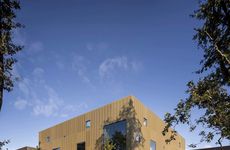
Kaan Architecten Boasts a Distraction-Free University Study Center
Kalin Ned — January 14, 2019 — Art & Design
References: kaanarchitecten & dezeen
Rotterdam-based studio Kaan Architecten undertook a stoic approach with a focus on minimalism for the construction of the Tilburg University study center. Situated in The Netherlands, the educational institution is surrounded by stunning vegetation and beautiful trees. Because of this, the architects sought to create an unobtrusive insert for the campus that offered strong functional opportunities and a seamlessly integrated aesthetic.
The university study center is aptly called 'Cube' -- an obvious nod to the structure's proportions. The focus of Kaan Architecten was to facilitate a space for students, faculty, and visitors that motivated collaboration. The uniformity and angularity of the structure add a sense of order. Thus, the cube fulfills its purpose as "a free flow" building which has "many sight lines."
Photo Credits: Sebastian van Damme, Simone Bossi
The university study center is aptly called 'Cube' -- an obvious nod to the structure's proportions. The focus of Kaan Architecten was to facilitate a space for students, faculty, and visitors that motivated collaboration. The uniformity and angularity of the structure add a sense of order. Thus, the cube fulfills its purpose as "a free flow" building which has "many sight lines."
Photo Credits: Sebastian van Damme, Simone Bossi
Trend Themes
1. Minimalism in Architecture - Creating distraction-free study centers with a focus on minimalism offers innovative design solutions for educational institutions.
2. Facilitating Collaboration - Designing spaces that motivate collaboration among students, faculty, and visitors provides opportunities for innovative learning environments.
3. Seamlessly Integrated Aesthetics - Achieving a seamless integration between architectural structures and natural surroundings opens up possibilities for visually pleasing and functional buildings.
Industry Implications
1. Architecture - The architecture industry can explore new ways of incorporating minimalism and collaboration-centered designs in educational institutions.
2. Education - The education industry can benefit from disruptive study center designs that promote collaboration and a distraction-free environment for students and faculty.
3. Construction - The construction industry has the opportunity to develop techniques and materials that allow for seamless integration between architectural structures and natural surroundings.
1.1
Score
Popularity
Activity
Freshness























